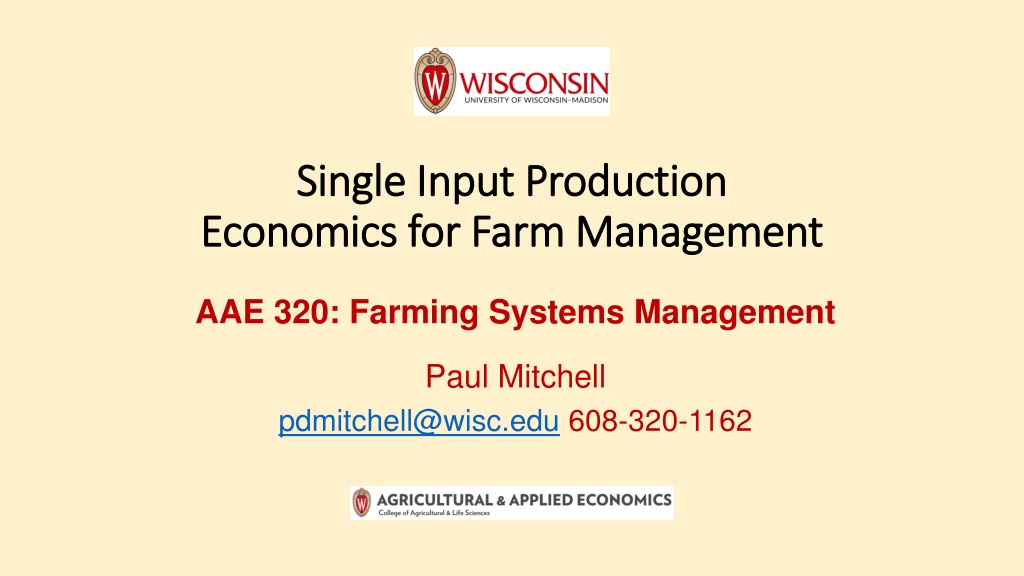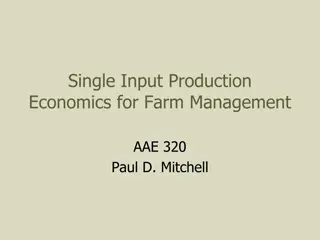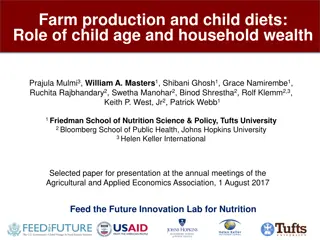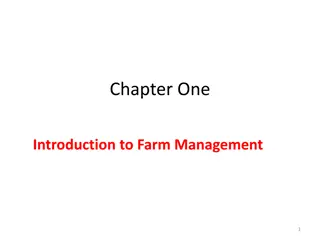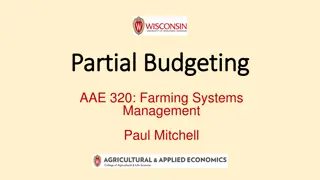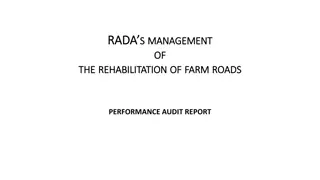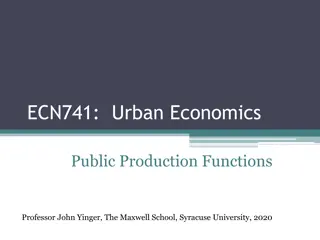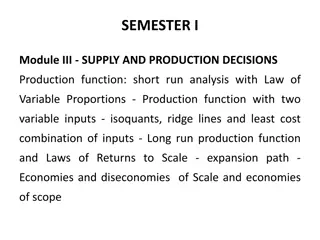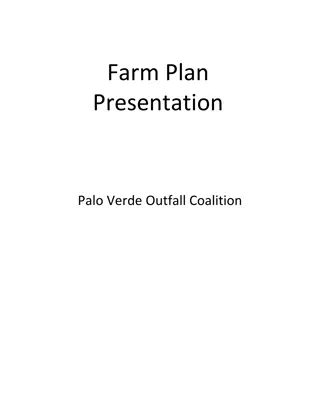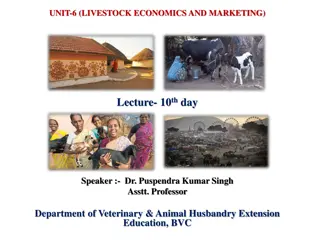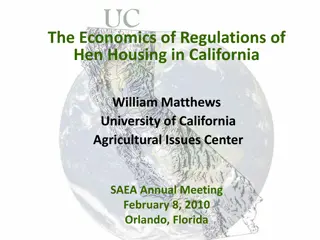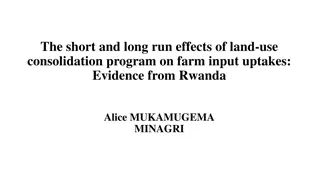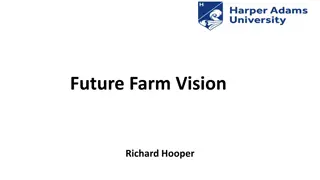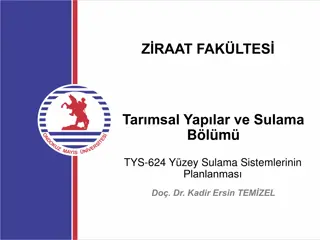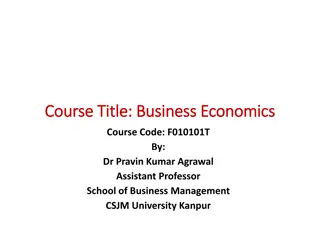Understanding Production Economics in Farm Management
Exploring production economics in farm management involves analyzing single and multiple input production functions to optimize output. By using inputs effectively, farms can generate goods and services of value. Different types of production functions such as linear, quadratic, and cubic are utilized to model the relationship between inputs and outputs in agriculture. Various factors like land, labor, machinery, and fertilizer play crucial roles in maximizing farm productivity.
- Production Economics
- Farm Management
- Input-Output Combinations
- Agricultural Productivity
- Production Functions
Uploaded on Sep 28, 2024 | 0 Views
Download Presentation

Please find below an Image/Link to download the presentation.
The content on the website is provided AS IS for your information and personal use only. It may not be sold, licensed, or shared on other websites without obtaining consent from the author. Download presentation by click this link. If you encounter any issues during the download, it is possible that the publisher has removed the file from their server.
E N D
Presentation Transcript
Single Input Production Single Input Production Economics for Farm Management Economics for Farm Management AAE 320: Farming Systems Management Paul Mitchell pdmitchell@wisc.edu 608-320-1162
Production Economics Learning Goals Single and Multiple Input Production Functions What are they and how to use them in production economics and farm management Economics to identify optimal input and output combinations How much nitrogen fertilizer do I use for my corn? How much corn will I get if I use this much nitrogen? Application of basic production economics to farm management
Production Definition: Using inputs to create goods and services having value to consumers or other producers Production is what farms do! Using land, labor, time, machinery, animals, seeds, fertilizer, water, etc. to grow crops, livestock, milk, eggs, etc. Can further process outputs: cheese, jams/jellies, baked goods Can produce services: bed and breakfast, orchard/pumpkin farm with hayrides selling the fall country experience
Production Function Production Function: gives the maximum amount of output that can be produced for the given input(s) Generally two types: Tabular Form (Production Schedule) Mathematical Function
Feed (1000 lbs TDN/yr) 0 1 2 3 4 5 6 7 8 9 10 11 12 13 14 Milk (lbs/yr) 0 800 1,700 3,000 5,000 8,500 11,700 14,600 17,200 19,400 21,000 22,000 22,600 22,800 22,900 Tabular Form A table listing the maximum output for each given input level TDN = total digestible nutrition (feed) 25,000 Mikl Production (lbs/yr) 20,000 15,000 10,000 5,000 0 0 2 4 Feed (1,000 lbs TDN) 6 8 10 12 14
Production Function Mathematically express the relationship between input(s) and output Single Input, Single Output Milk = f(TDN) Milk = 50 + 3TDN 0.2TDN2 Multiple Input, Single Output Milk = f(Corn, Soy) Milk = 50 + 3Corn 0.2Corn2 + 2Soy 0.1Soy2 + 0.4CornSoy
Examples Polynomial: Linear, Quadratic, Cubic Milk = b0 + b1TDN + b2TDN2 Milk = 2261 + 2.535TDN 0.000062TDN2 Many functions are used, depending on the process: Cobb-Douglas, von Liebig (plateau), Exponential, Hyperbolic, etc.
Why Production Functions? More convenient & easier to use than tables Estimate via regression with the tables of data from experiments Increased understanding of production process: identify important factors and how important factor each is Allows use of calculus for optimization Common activity of agricultural research scientists
Definitions Input: X Output: Q Total Product = Output Q Average Product (AP) = Q/X: average output for each unit of the input used Example: you harvest 200 bu/ac corn and applied 100 lbs of nitrogen AP = 200/100 = 2, means on average, you got 2 bu of corn per pound of nitrogen applied Graphics: slope of line between origin and the total product curve
Definitions Marginal Product (MP) = Q/ X or derivative dQ/dX: Output Q generated by the last unit of input used or applied Example: corn yield increases from 199 to 200 bu/ac when you increase nitrogen applied from 99 lbs to 100 lbs MP = 1/1 = 1, meaning you got 1 bu of corn from last 1 pound of nitrogen applied MP: Slope of total product curve
Graphics Output Q 1)MP = 0 when Q at maximum, i.e. slope = 0 1 Q 2 2)AP = MP when AP at maximum, at Q where line btwn origin and Q curve tangent Input X MP AP 3)MP > AP when AP increasing 3 4 4)AP > MP when AP decreasing AP Input X MP
MP and AP: Tabular Form Input TP MP 0 1 2 16 3 29 4 44 5 55 6 60 7 62 8 62 9 61 10 59 AP MP = Q/ X = (Q2 Q1)/(X2 X1) AP = Q/X 0 6 6 10 13 15 11 5 2 0 -1 -2 6.0 8.0 9.7 11.0 11.0 10.0 8.9 7.8 6.8 5.9 MP: 6 = (6 0)/(1 0) AP: 8.0 = 16/2 MP: 5 = (60 55)/(6 5) AP: 8.9 = 62/7
Same Data: Graphically 55 TP MP AP 35 15 -5 0 2 4 6 8 10
Think Break #2 N 0 Yield 30 45 75 105 135 150 165 168 170 171 AP --- 1.8 MP --- 0.6 1.2 Nitrogen (N) and Corn Yield Fill in the missing numbers in the table for the Average Product (AP) and the Marginal Product (MP) Remember the Formulas MP = Q/ X = (Q2 Q1)/(X2 X1) AP = Q/X 25 50 75 100 125 150 175 200 225 1.4 1.35 1.2 0.6 1.1 0.96 0.85 0.76 0.12 0.08 0.04
Law of Diminishing Marginal Product Diminishing MP: Holding all other inputs fixed, as you use more and more of one input, eventually the MP starts decreasing The returns to increasing that input eventually start to decrease Common in biological, physical and social systems: eventually the marginal product (MP) starts to decrease As you make more and more feed available to a cow, the extra milk produced eventually starts to decrease As add more corn acres (holding all other inputs fixed), the extra corn produced eventually decreases due to less time to plant and for crop care, more time travel between fields, only lower quality land available,
Transition We spent time explaining production functions Q = f(X) and their slope = MP, and AP = Q/X Now we can ask: How do we use them? How do I decide how much input to use? How much nitrogen should I use for my corn? How many soybean seeds should I plant per acre? Choose each input to maximize farmer profit We will set it up as an economic problem First as partial budget and then use calculus
Suppose you apply 99 pounds of Nitrogen per acre to corn. Should you apply 100 pounds? Benefits Additional Revenues Extra yield = 180 bu 179 bu = 1 bu/acre x $3.00/bu = $3.00/acre (Value of the MP) Costs Reduced None Costs Additional Costs $0.50/lb x 1 lb of N/acre = $0.50/acre (Input price) Assumptions Corn Price $3.00/bu N price $0.50/lb Revenues Reduced None Total Benefits Total Benefits Total Costs = Net Gain $3.00/ac Total Costs $0.50/acre $2.50/acre
$2.50 x Q Benefit of Extra N --- $37.50 $75.00 $75.00 $75.00 $37.50 $37.50 $7.50 $5.00 $2.50 $0.30 x N Cost of Extra N --- $7.50 $7.50 $7.50 $7.50 $7.50 $7.50 $7.50 $7.50 $7.50 Partial budget analysis for each addition of N fertilizer Do I add 25 more lbs of N fertilizer? Corn price = $2.50/bu N price = $0.30/lb N Yield bu/ac 30 45 75 105 135 150 165 168 170 171 lbs/ac 0 25 50 75 100 125 150 175 200 225 What if you only wanted to add one more pound of N? Let s divide the Benefit and Cost by the N of 25 pounds Gives the net gain for 1 extra pound of N
$2.50 x Q Q/N $2.50 x Q/N Benefit of Extra N MP --- --- $37.50 0.6 $75.00 1.2 $75.00 1.2 $75.00 1.2 $37.50 0.6 $37.50 0.6 $7.50 0.12 $5.00 0.08 $2.50 0.04 $0.30 x N Cost of Extra N --- $7.50 $7.50 $7.50 $7.50 $7.50 $7.50 $7.50 $7.50 $7.50 $0.30 x N/ N Cost of 1 extra lb of N --- $0.30 $0.30 $0.30 $0.30 $0.30 $0.30 $0.30 $0.30 $0.30 Benefit of 1 extra lb of N --- $1.50 $3.00 $3.00 $3.00 $1.50 $1.50 $0.30 $0.02 $0.01 N 0 25 50 75 100 125 150 175 200 225 Yield 30 45 75 105 135 150 165 168 170 171
Graphics Yield MP 180 1.4 160 1.2 140 1 120 0.8 100 80 0.6 60 0.4 40 0.2 20 0 0 0 50 100 150 200 250 0 50 100 150 200 250
Intuition If you take a partial budget analysis and divide by X (the change in X in the table), you convert it to a partial budget analysis of a 1 unit change in the input X The Benefit will be the Marginal Product times the output price, or the Value of the Marginal Product (VMP) The Cost will be the cost of 1 unit of X, the Input Price How much X to use? Where the VMP = Input Price is the break even X if you did a partial budget analysis Keep increasing X until the gain the last bit of input generates just equals the cost of buying the last bit of input
Milk Cow Feed Example r Q X Feed 0 1 2 3 4 5 6 7 8 9 10 11 12 13 14 Milk 0 800 1,700 3,000 5,000 8,500 11,700 3200 $576 14,600 2900 $522 17,200 2600 $468 19,400 2200 $396 21,000 1600 $288 22,000 1000 $180 22,600 600 22,800 200 22,900 100 MP VMP Feed Price profit -$400 -$436 -$454 -$400 -$220 $230 $626 $968 $1,256 $1,472 $1,580 $1,580 $1,508 $1,364 $1,202 Milk Price = $18/cwt or p = $0.18/lb $180 $180 $180 $180 $180 $180 $180 $180 $180 $180 $180 $180 $180 $180 $180 800 900 1300 $234 2000 $360 3500 $630 $144 $162 Feed Price = $180 for 1,000 lbs Fixed Cost = $400/yr Price Ratio r/p = $180/$0.18 = 1,000 VMP = r at Feed = 11 Optimal Feed = 11 $108 $36 $18 MP = r/p = 1,000
25,000 r/p Mikl Production (lbs/yr) 20,000 Profit Max occurs where VMP = r 15,000 10,000 Where line with slope of r/p = MP, or is tangent to the production function 5,000 0 0 2 4 6 8 10 12 14 Feed (1,000 lbs TDN) 4,000 r/p = 180/0.18 = 1,000 3,500 Marginal Product 3,000 2,500 Where MP = r/p line 2,000 1,500 r/p 1,000 500 0 0 2 4 6 8 10 12 14 Feed (1,000 lbs TDN)
Another Way to Find Optimal Input Use Have derived the profit maximizing condition defining optimal input use p x MP = r or VMP = r Rearrange this condition to get an alternative: MP = r/p Find the amount of X where the MP equals r/p r/p is the Relative Price of input X, how much X is worth in the market relative to Q r is $ per unit of X, p is $ per unit of Q Ratio r/p is units of Q per one unit of X r/p is how much Q you could buy if you traded in one unit of X r/p is the cost of X if you were buying X in the market using Q in trade
MP = r/p and Cow Feed r = $/ton of TDN (Feed), p = $/cwt of milk, so r/p = ($/ton)/($/cwt) = cwt/ton, or the hundredweight of milk you could buy if you traded in one ton of feed MP = cwt of milk from the last ton of feed MP = r/p means to find the amount of Feed that gives the same conversion between Feed and milk in the production process as in the market, or find the Feed amount that sets the Marginal Benefit of Feed = Marginal Cost of Feed
Milk Cow Feed Example: Key Points Profit maximizing Feed is less than output maximizing Feed, which implies profit maximization output maximization Profit maximizing Feed occurs at Feed levels where MP is decreasing, meaning that you use Feed where it has a diminishing MP Profit maximizing Feed depends on both the Feed price and the milk price Profit maximizing Feed same whether use VMP = r or MP = r/p to identify optimal Feed
Think Break #3 N Yield bu/A 30 45 75 105 135 150 165 168 170 171 lbs/A 0 25 50 75 100 125 150 175 200 225 MP --- 0.6 1.2 1.2 1.2 0.6 0.6 0.12 0.08 0.04 VMP --- Fill in the VMP column in the table using $3/bu for the corn price. What is the profit maximizing N fertilizer rate if the N fertilizer price is $0.5/lb?
Why We Need Calculus What do you do if the VMP = r is not in the table? If you have the production function Q = f(X), then you can use calculus to derive an equation for the MP = f (X) With an equation for MP, you can fill in the gaps in the tabular form of the production schedule
Calculus and AAE 320 I will keep the calculus simple!!! Production Functions will be Quadratic Equations: Q = f(X) = a + bX + cX2 First derivative = slope of production function = Marginal Product 3 different notations for derivatives dy/dx (Newton), f (x) and fx(x) (Leibniz) 2nd derivatives: d2y/dx2, f (x), fxx (x)
Quick Review of Derivatives Constant Function If Q = f(X) = K, then f (X) = 0 Q = f(X) = 7, then f (X) = 0 Power Function If Q = f(X) = aXb, then f (X) = abXb-1 Q = f(X) = 7X = 7X1, then f (X) = 7(1)X1-1 = 7 Q = f(X) = 3X2, then f (X) = 3(2)X2-1 = 6X Sum of Functions Q = f(X) + g(X), then dQ/dX = f (X) + g (X) Q = 3 + 5X 0.1X2, dQ/dX = 0 + 5 0.2X
Think Break #4 What are the 1st and 2nd derivatives with respect to X of the following functions? 1. Q(X) = 4 + 15X 7X2 2. (X) = 2(5 X 3X2) 8X 15
Calculus-Based Approach to Optimal Input Use Mathematical Model: Profit = Revenue Cost Profit = price x output input cost fixed cost = pQ rX K = pf(X) rX K = profit Q = output X = input f(X) = production function p = output price r = input price K = fixed cost Learn this model, we will use it a lot!!!
Calculus-Based Approach to Optimal Input Use Find X to Maximize profit (X) = pf(X) rX K Calculus: Set first derivative of with respect to X equal to 0 and solve for X, the First Order Condition (FOC) FOC: pf (X) r = 0 Rearrange: pf (X) = r p x MP is the Value of the Marginal Product (VMP), what would get if sold the MP FOC means to increase use of the input X until p x MP = r, or until the VMP = r, the input price p x MP r = 0 p x MP = r
Calculus of Optimization Problem: Choose X to Maximize some function g(X) First Order Condition (FOC): Set g (X) = 0 and solve for X May be more than one X (not in this class) Call these potential solutions X* Identifying X values where the slope of the objective function is zero (satisfies the FOC) Use SOC to see if at maximum or minimum
Calculus of Optimization Second Order Condition (SOC) Evaluate g (X) at each X* identified Condition for a maximum is g (X*) < 0 Condition for a minimum is g (X*) > 0 g (X) is the function's curvature at X Positive curvature is convex (minimum) Negative curvature is concave (maximum)
Calculus of Optimization: Intuition FOC: finding the X values where the objective function's slope is zero, candidates for minimum/maximum SOC: checks curvature at each candidate solution identified by setting FOC equal to zero Maximum is curved down (2nd derivative negative) Minimum is curved up (2nd derivative positive)
Example 1 Choose X to maximize g(X) = 5 + 6X X2 FOC: g (X) = 6 2X = 0 FOC satisfied when X = 3 Is this a maximum or a minimum or an inflection point? How do you know? Check the SOC: g (X) = 2 < 0 Negative, satisfies SOC for a maximum The value of g(X) at X = 3: g(3) = 5 + 6(3) 32 = 4
Example 1: Graphics Slope = 0 8 g (X) = 0 6 4 2 g(X) and g'(X) g(X) g'(X) 0 0 1 2 3 4 5 6 -2 -4 -6 -8 Input X
Example 2 Choose X to maximize g(X) = 10 6X + X2 FOC: g (X) = 6 + 2X = 0 FOC satisfied when X = 3 Is this a maximum or a minimum or an inflection point? How do you know? Check the SOC: g (X) = 2 > 0 Positive, does not satisfy SOC for maximum The value of g(X) at X = 3: g(3) = 10 6(3) + 32 = 1
Example 2: Graphics What value of X maximizes this function? Slope = 0 12 10 8 g (X) = 0 6 g(X) and g'(X) 4 g(X) g'(X) 2 0 0 1 2 3 4 5 6 -2 -4 -6 -8 Input X
Think Break #5 Choose X to Maximize: (X) = 10(30 + 5X 0.4X2) 2X 18 1) What X satisfies the FOC? 2) Does this X satisfy the SOC for a maximum? 3) What is (X) at this X?
Calculus and Production Economics In general, (X) = pf(X) rX K Suppose your production function is Q = f(X) = 30 + 5X 0.4X2 Suppose output price is 10, input price is 2, and fixed cost is 18, then = 10(30 + 5X 0.4X2) 2X 18 To find X to maximize , solve the FOC and check the SOC, can then calculate output and profit
Calculus and Production Economics Solve for X = 6, check SOC, confirm that it is a maximum Plug 6 back into the profit function to calculate output Q and then profit Q(X) = 30 + 5X 0.4X2 Q(6) = 45.6 (X) = 10(Q) 2X 18 (6) = 10(45.6) 30 = 426 = 10(30 + 5X 0.4X2) 2X 18 FOC: 10(5 0.8X) 2 = 0 10(5 0.8X) = 2 p x MP = r 5 0.8X = 2/10 MP = r/p When solving the FOC, you set VMP = r and/or MP = r/p & solve for X
Summary: Single Input Production Function Condition to find optimal input use: VMP = r or MP = r/p What does this condition mean? What does it look like graphically? Know how to use condition to find optimal input use and corresponding output and profit 1) With a production schedule (table) 2) With a production function (calculus)
